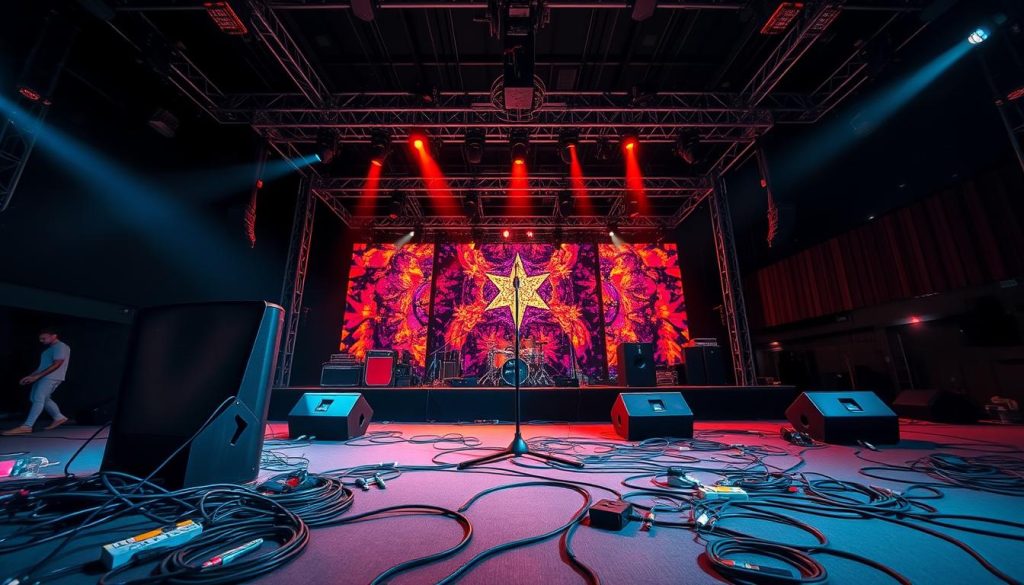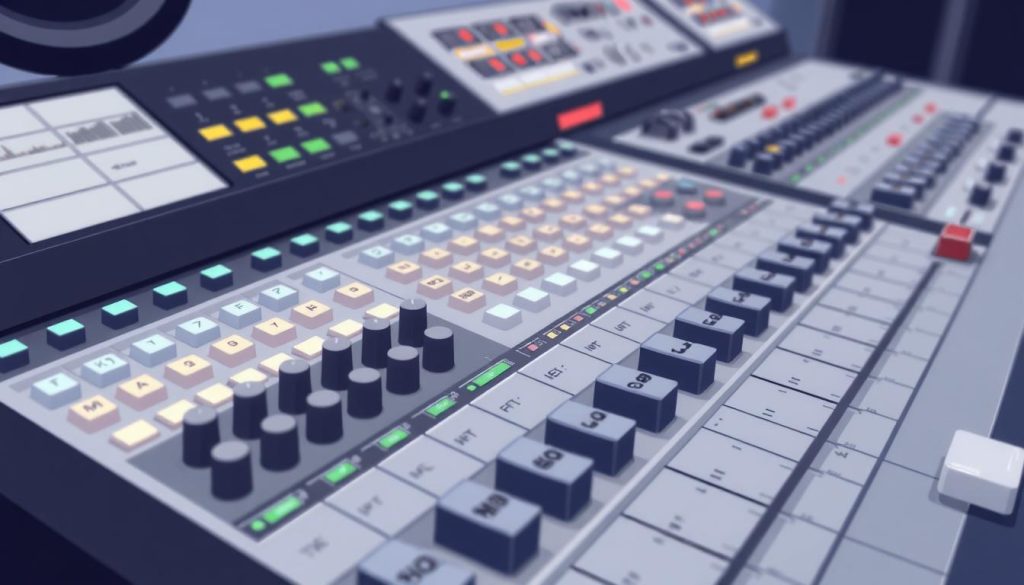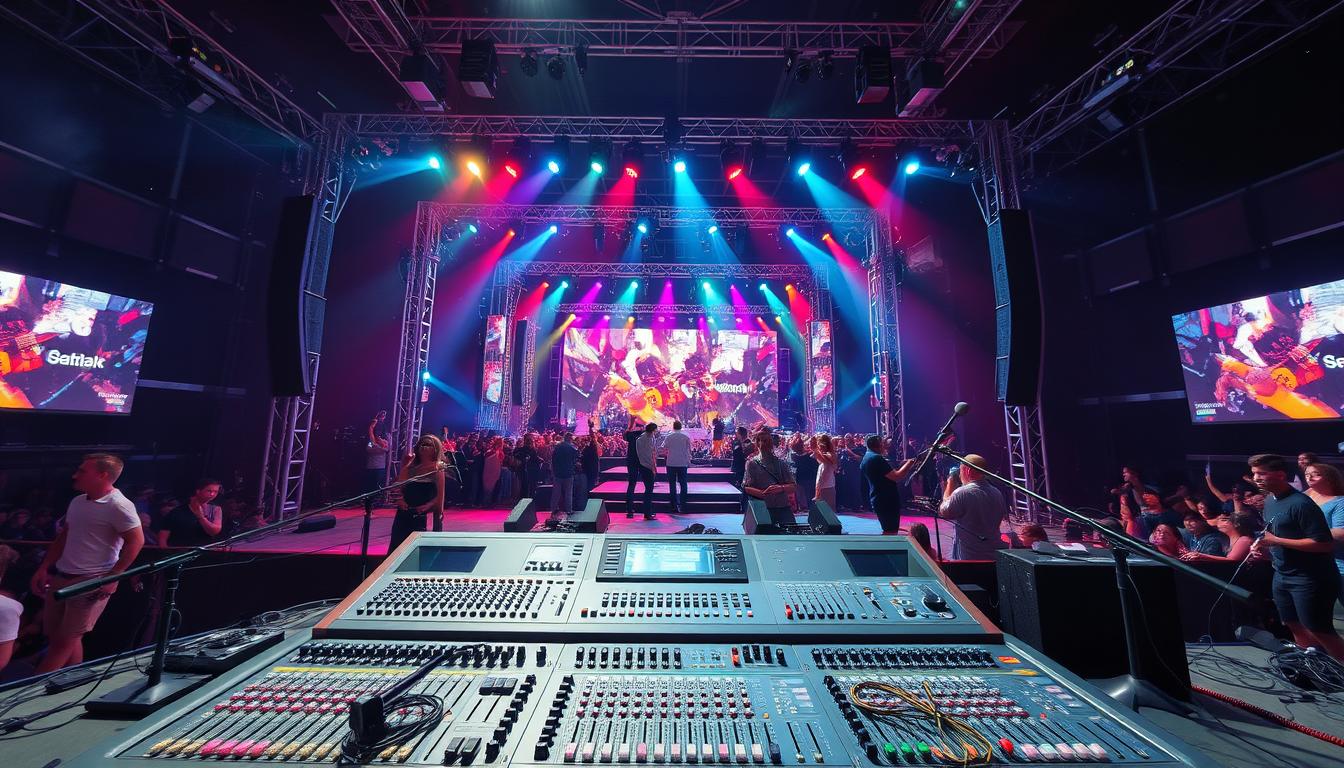Setting up the audio for a concert is very important. It can change the whole show. Over time, I’ve learned that a good sound setup is key for a great live music event. Here, I’ll share some tips and techniques to help you set up for a concert smoothly and professionally.
For a great concert sound setup, you need to prepare well and pay attention to details. This means planning the channel list and stage setup, and working with the venue’s engineer. Each step is important for a good audio system. I’ll explain these steps in detail to help you make the performance perfect.
Do Your Homework: Planning for a Successful Soundcheck
Being a sound engineer means you must prepare well before a live concert. This means planning and doing your homework. It’s important to make a detailed channel list and stage plan, and to analyze the band’s recordings.
Draw Up a Channel List and Stage Plan
Work with the band to make a channel list before the concert. This list should include every instrument, vocal, and audio source for the show. Share this list with the venue’s sound team early so they can prepare.
Also, make a stage plan that shows where everything goes. This will help during setup and soundcheck, making things run smoothly.
Analyze the Band’s Recordings
Listen to the band’s studio recordings to prepare for the concert. Pay attention to the tones and mix of the songs. This helps you understand their sound, making it easier to recreate it during the show.
Doing these important tasks before the show helps a lot. It makes the soundcheck go well and helps you give a great live performance.
First Impressions: Building Rapport with the Venue’s Engineer
As a sound engineer, making a great first impression is crucial. When I get to the venue, I say hello and thank them for their hard work. They keep the sound system running smoothly.
Working well with the house crew is key for a smooth setup. A simple act like offering tea or coffee can make things more friendly. I listen to their advice and work closely with the venue sound engineer to solve problems.
Getting along with the house crew helps us work better together. We can fix issues or adjust the sound easily. This teamwork makes the concert sound amazing.
Being patient and flexible is important. The venue’s engineer might do things their way. I try to work together to make the best sound for everyone.
Getting along with the venue’s sound engineer is vital. By being friendly and appreciative, I can work seamlessly with the house crew. This makes the event a success.
Keeping It Neat: Stage Setup and Cable Management

Having a clean concert stage setup helps with your soundcheck and performance. Managing cables and mic stands well is key. By coiling cables and storing mic stands right, you keep the stage looking good. This also helps you find problems faster if they happen during the show.
Coil Cables and Store Mic Stands Neatly
Keeping cables tidy is important for a pro-looking stage. Here are some tips:
- Coil extra cable lengths neatly with a figure-eight or velcro ties.
- Put cables along the stage edges or under rugs to hide them and avoid tripping.
- Label each cable so you can easily find its spot during setup.
It’s also key to keep mic stands in order. This makes your stage look better:
- Fold mic stands and put them away in holders or cases when not needed.
- Place mic stands where they won’t block the artists or the audience.
- Use collapsible or foldable stands to save space on the stage.
By using these tips for cables and mic stands, you’ll have a neat stage setup. It looks professional and makes your setup and performance smoother.
| Cable Organization Technique | Benefit |
|---|---|
| Coiling cables in a figure-eight pattern | Prevents tangling and kinking, makes it easier to uncoil and reuse the cable |
| Labeling cables with their corresponding inputs/outputs | Simplifies troubleshooting and replugging during setup and performance |
| Storing mic stands in designated holders or cases | Keeps the stage clear and organized, protects the mic stands from damage |
Analogue or Digital: Mixing Console Approach

Choosing between an analog or digital mixing console is key. Analog desks need a smart channel layout and clear labels for live shows. Digital consoles let you arrange channels to fit your needs, making important things easy to find.
Analog Console Setup
Start with an analog console by setting all gains and EQs to zero. This gives you a clean start, avoiding unwanted sound changes. Then, label each channel clearly to keep track of inputs and their roles.
Digital Console Layout
With digital consoles, how you arrange channels is important. Put vital elements like lead vocals and drums on the main layer for quick access. This setup helps you adjust key parts fast during the show, improving your workflow.
Whether you’re using an analog or digital console, planning your channel layout and labels is crucial. A well-organized setup helps you deliver great sound for everyone at the concert.
System Check: Listening to the PA and Troubleshooting
As the stage is set and the equipment is ready, it’s time for a detailed system check. This step makes sure the PA system works well. It helps spot and fix any issues before the show starts.
I put on high-quality headphones to listen to the PA system. This lets me find any bad sounds or issues with the room’s sound. By checking the sound quality, I can fix problems to make the system better for the venue.
A frequency analyzer is a key tool for this job. It shows me the sound’s frequencies and where there are problems. With this info, I can adjust the PA system. I make sure the sound is balanced and clear everywhere in the room.
Doing a PA system test, fixing live sound problems, and checking room sound are key for great concert sound. By carefully checking and improving the system, I make sure the artists sound their best. The audience gets to enjoy a great show.
The Art of concert sound setup: Tips from the Pros
I’ve learned a lot from top sound engineers like Brian Pomp and Shan Hira. They’ve shared their top tips on setting up concert sound. I’m excited to share their advice with you.
Brian says knowing about gain structure is key. “It helps you handle loud bands and keeps your sound clear,” he explains. Shan adds, “Watch your meters closely. Adjust them to keep your sound clear and strong.”
Brian and Shan say it’s important to keep up with new audio tech. “The music world changes fast,” says Shan. “Learning about new gear and techniques helps you stand out.”
Brian believes the secret to great concert sound is mixing live and studio skills. “The basics are the same, but live shows are different. Being quick-thinking and solving problems fast is crucial.”

